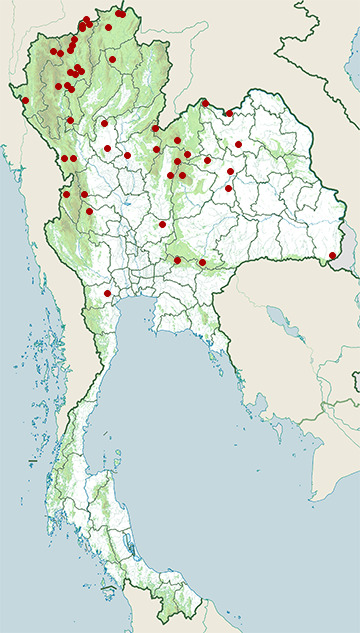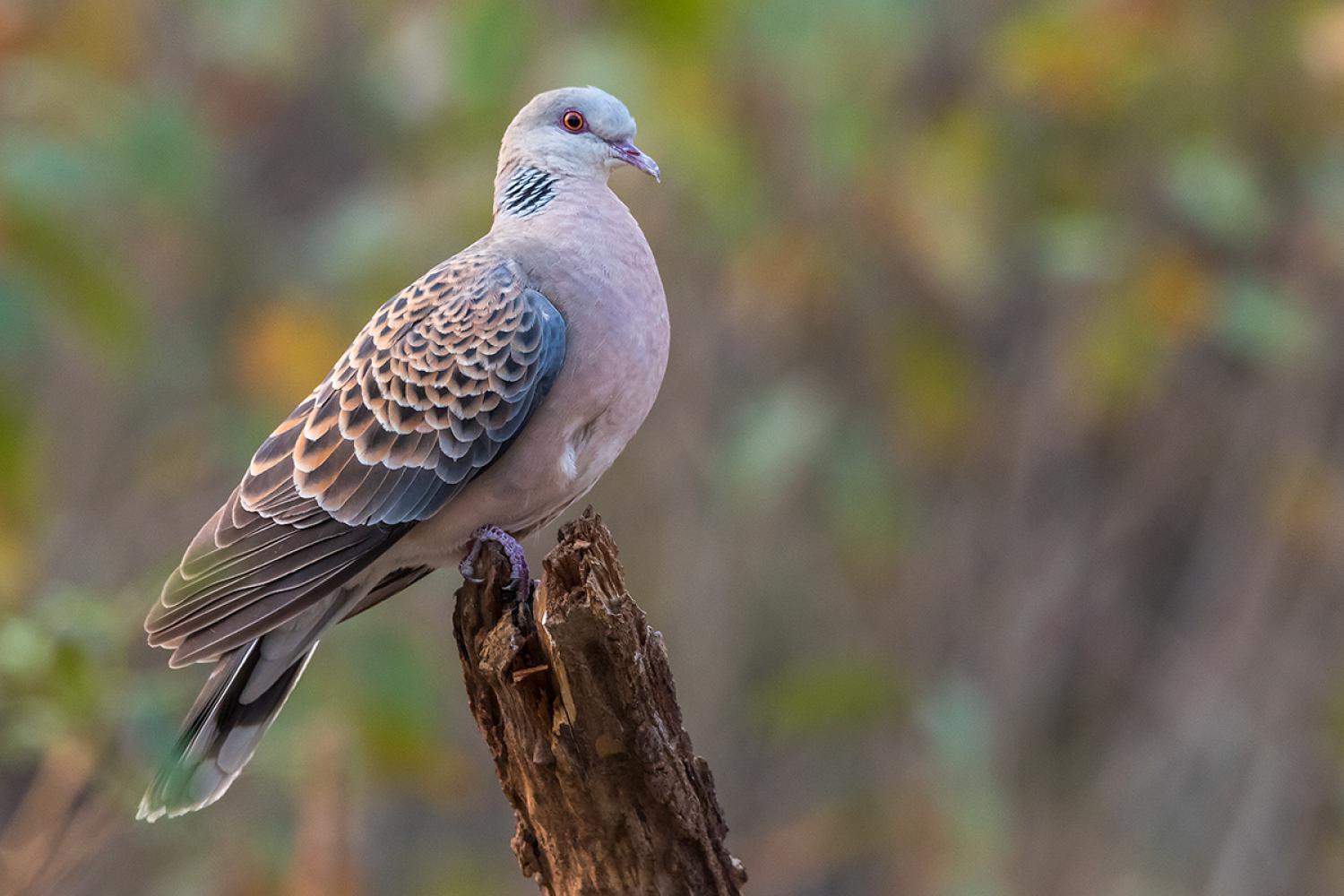Species of Thailand
Oriental turtle dove
Streptopelia orientalis
John Aubrey Clarendon Latham, 1790
In Thai: นกเขาพม่า
The oriental turtle dove or rufous turtle dove (Streptopelia orientalis) is a member of the bird family Columbidae. The species has a wide native distribution range from Europe, east across Asia to Japan. The populations show variations in the patterning of plumage and have been designated into at least six named subspecies. Populations in the higher latitudes tend to migrate south in winter while those closer to the tropics are sedentary. Vagrants have been recorded in North America. The species is predominantly granivorous and forages on the ground.
Taxonomy
The genus name Streptopelia is from Ancient Greek streptos, "collar" and peleia, "dove". The specific orientalis is Latin for "eastern", in this case referring to the type locality, China.
The species has a wide distribution with geographical variation in plumage that has led to at least six subspecies being designated. The distributions of many are not disjunct and gradation exists except in some island populations. Some of the populations of Streptopelia turtur that occur on the eastern edge can be very similar in appearance to S. orientalis and in the past the two species have been lumped together.
- S. o. meena (Sykes, 1832) – eastern Asia and Central Asia south to the Himalayas from Kashmir to central Nepal. Winters in India as far south as Sri Lanka.
- S. o. orientalis (Latham, 1790) – central Siberia to Japan and Korea south to the Himalayas from Assam to Yunnan and northern Vietnam. Winters in South and Southeast Asia (includes S. baicalensis Buturlin).
- S. o. stimpsoni (Stejneger, 1887) – an insular subspecies from the Ryukyu Islands.
- S. o. orii Yamashina, 1932 – Taiwan.
- S. o. erythrocephala (Bonaparte, 1855) – southern peninsular India. This subspecies is reddish-brown on the head with no grey on the forehead or crown, unlike in other subspecies. The undertail coverts and terminal tail band are slaty grey.
- S. o. agricola (Tickell, 1833) – from Orissa and Bengal to northeastern India and into Myanmar south to Hainan.
The Oriental turtle dove has two distinct migratory northern subspecies, S. o. orientalis in the central Siberian taiga, and S. o. meena in the open woodlands of central Asia. The differences in the tail patterns of the subspecies S. o. orientalis and S. o. meena help separate identification in their wintering grounds. The nominate form is described as having a grey tip to the tail and more black in the outer web of the outer tail feathers, while meena has a white tip to its tail like the European turtle dove and less black in the outer web of the outer tail feathers. However, these are not consistent differences: both forms can have white or grey tail-bands and orientalis can have little black in the outer webs of the outer tail feathers.
Description
The Oriental turtle dove is very similar in plumage to the European turtle dove. It is a little larger than that species, particularly in the case of orientalis, about the same size as a collared dove. It shares the black and white striped patch on the side of its neck made of silver-tipped feathers, but the breast is less pink, and the orange-brown wing feathers of the turtle dove are replaced with a browner hue, and darker centres giving a scaly appearance. The tail is wedge shaped, like the turtle dove. The flight is more relaxed and direct than that of its relative.
Call
The calls are different from the purring of the European turtle dove. It is a four-syllable her-her-oo-oo. There are significant call differences within the populations as well.
Distribution and habitat
The habitat varies, but the Oriental turtle dove breeds in well-wooded but open habitats and winters in more open habitats but usually with good tree cover.
The westernmost race, meena, breeds in the Western Palearctic region. The southernmost populations are resident, but most other birds migrate south to winter in India, the Maldives, and southern Japan. They disperse widely and are known from islands such as the Lakshadweep in winter. S. o. orientalis occurs as a rarity in western Alaska and British Columbia. It is also a vagrant to northern and western Europe and occurrences in Britain tend to gather much attention from twitchers.
Breeding
The summer breeding season in the temperate zone can be protracted. In southern India, the breeding season is in winter. In display, the male flaps its wing noisily and shoots up before gliding down with outspread tail. Nests take about two days to build with the male gathering material and the female placing it. The nest is more substantial than in some other doves and is placed at mid-canopy height. In Japan, nests built at a greater height tended to be prone to predation. Males were found to incubate in the day and the female by night. Two white eggs, as for all pigeons and doves, are laid in a twig nest in a tree. Incubation begins immediately after the first egg is laid. The eggs hatch in 15 to 16 days and the chicks take about 15 to 17 days to fledge (in Japan). Both parents feed the chicks with crop milk. Multiple broods may be raised and nests built by the pair or by others may be reused.Nest reuse may possibly increase the chances of predation. In Japan the principal predators of nestlings and eggs were crows and magpies and to a lesser extent cats and snakes.
Diet
The Oriental turtle dove is granivorous, and feeds on the seeds of hemp, sunflower, wheat, millet and amaranth. It also consumes gastropods. They forage on the ground.
Parasites and diseases
Nests in Japan that have accumulated faeces have been found to host a number of flies belonging to the families Sphaeroceridae, Sepsidae, and Stratiomyidae.
Subcutaneous mites of the species Hypodectes propus have been recorded in Japan. Deaths of a number of birds due to avian pox virus have been recorded in South Korea.
Other associations
On Hongdo Island, Korea, migratory doves were found to carry seeds of the exotic Achyranthes japonica attached to their plumage.
This article uses material from Wikipedia released under the Creative Commons Attribution-Share-Alike Licence 3.0. Eventual photos shown in this page may or may not be from Wikipedia, please see the license details for photos in photo by-lines.
Category / Seasonal Status
BCST Category: Recorded in an apparently wild state within the last 50 years
BCST Seasonal statuses:
- Resident or presumed resident
- Non-breeding visitor
Scientific classification
- Kingdom
- Animalia
- Phylum
- Chordata
- Class
- Aves
- Order
- Columbiformes
- Family
- Columbidae
- Genus
- Streptopelia
- Species
- Streptopelia orientalis
Common names
- English:
- Oriental turtle dove
- Rufous turtle dove
- Thai: นกเขาพม่า
Conservation status

Least Concern (IUCN3.1)
Photos
Please help us review the bird photos if wrong ones are used. We can be reached via our contact us page.
Range Map

- Ban Phai District, Khon Kaen
- Chai Badan District, Lopburi
- Chiang Dao District, Chiang Mai
- Chiang Dao Wildlife Sanctuary
- Chiang Saen District, Chiang Rai
- Doi Inthanon National Park
- Doi Lang
- Doi Lo District, Chiang Mai
- Doi Pha Hom Pok National Park
- Doi Saket District, Chiang Mai
- Doi Suthep - Pui National Park
- Fang District, Chiang Mai
- Huai Kha Khaeng Wildlife Sanctuary
- Huai Nam Dang National Park
- Khao Yai National Park
- Kumphawapi District, Udon Thani
- Mae Ai District, Chiang Mai
- Mae Ping National Park
- Mae Sot District, Tak
- Mae Wong National Park
- Mueang Chiang Mai District, Chiang Mai
- Mueang Chiang Rai District, Chiang Rai
- Mueang Khon Kaen District, Khon Kaen
- Mueang Nong Khai District, Nong Khai
- Mueang Phayao District, Phayao
- Mueang Phitsanulok District, Phitsanulok
- Mueang Ratchaburi District, Ratchaburi
- Mueang Sukhothai District, Sukhothai
- Nam Nao National Park
- Nong Bong Khai Non-Hunting Area
- Pa Sang District, Lamphun
- Pai District, Mae Hong Son
- Pha Daeng National Park
- Phu Chong Na Yoi National Park
- Phu Hin Rong Kla National Park
- Phu Khiao Wildlife Sanctuary
- Phu Kradueng National Park
- Phu Luang Wildlife Sanctuary
- Phu Suan Sai National Park
- Phu Wiang National Park
- Salawin National Park
- San Sai District, Chiang Mai
- Sangkhom District, Nong Khai
- Si Satchanalai District, Sukhothai
- Taksin Maharat National Park
- Tat Mok National Park
- Thap Lan National Park
- Umphang Wildlife Sanctuary



